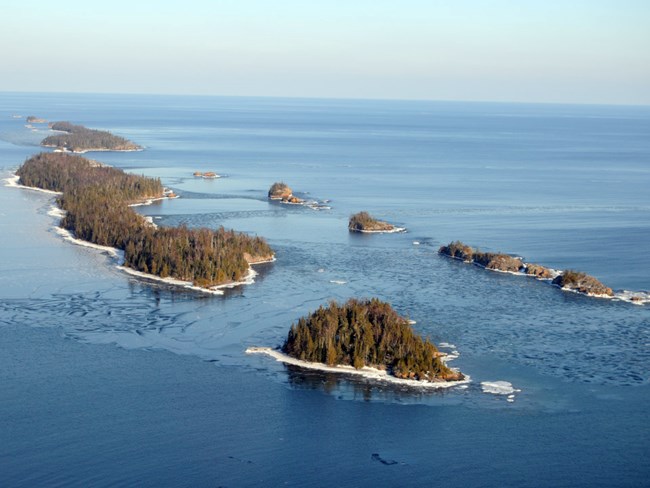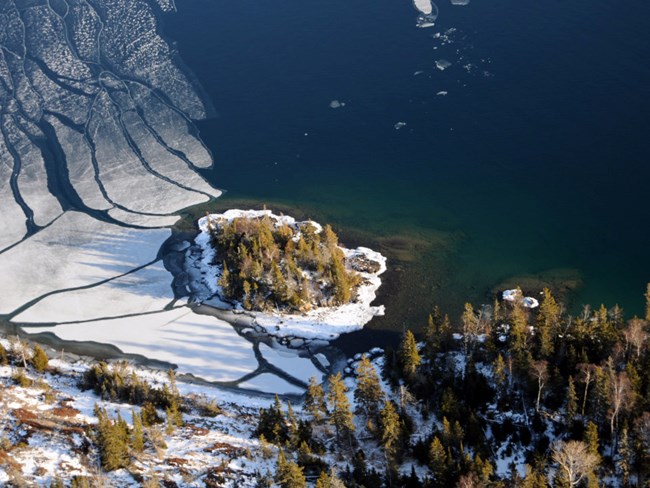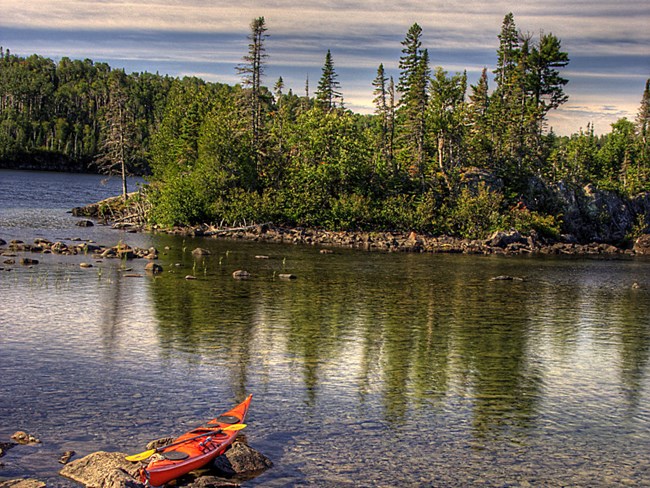Last updated: May 28, 2024
Article
Heritage of Minong

NPS Photo / Paul Brown
The Grand Portage Band
The Grand Portage Band of Lake Superior Chippewa (Ojibwe) is a federally recognized tribe distinct from other Ojibwe bands living along Lake Superior shores in Wisconsin and Michigan. Their reservation is in the extreme northeastern corner of Minnesota, the closest mainland point to Isle Royale. Many of their close kinsmen live in Thunder Bay, Ontario (the Fort William First Nation) separated from Grand Portage when the U.S.-Canadian Boundary was finally established in 1842. Other close kinsmen are Ojibwe tribes living to the west along the international border. Grand Portage band members speak a "border lakes dialect" different than those Ojibwe on the south shore of Lake Superior. Grand Portage band members clans - large extended families - are different in make up from south shore bands. Prior to the treaty period in the mid-1800s there was comparatively little contact between Grand Portage Ojibwe and those on the south shore. Grand Portage history, with one of the largest fur trade emporiums in North America in their midst, was different in scale and extent than what other Lake Superior tribes experienced. And prior to and post 1842 Treaty and 1844 Isle Royale Compact, Grand Portage Band members were the dominant and virtually exclusive American tribe to resort to Minong (their kinsmen from Fort William First Nation in Canada also continued to go to Island).

NPS Photo / Paul Brown
Islands and Gichigami
Most Ojibwe bands live in an environment noteworthy for its fusion of lands and fresh water. The Great Lakes and the Canadian Shield perch vast expanses of water over the Ojibwe homelands. Lakes, rivers, and streams dot and define Ojibwe homelands. For the Grand Portage Ojibwe Gichigami - Lake Superior - dominates their viewshed, provides reliable and tasty foods, interposes into their cultural systems, and marks their lives. For Portagers, Minong is a familiar silhouette on the eastern horizon as is the vast stretches of Gichigami. Each morning, the sun rises over Gichigami, Minong, or closer by Grand Portage Island.
Islands are a compromise of lands and waters and thus islands, too, mark the Ojibwe landscape. The traditional territory of the Grand Portage Ojibwe is replete with islands, near and far. Grand Portage Island protects their harbor, the Susie Island archipelago is a way stop on the water to Minong. When the air is clear and there is little lake haze or fog in the air, Minong materializes in the distance. The horizon across the water is sweeping and the Island seems to blend into water or the Island is amplified in size by mirages. In contrast, because of the greater distance and curve of the earth, it is not visible from the south shore of Lake Superior (from Michigan or Wisconsin). Stories were once told about it being a floating island.
Islands and Gichigami are also central to Ojibwe thought and belief systems. They feature prominently in sacred narratives - aadizookaan. In one of the creation stories, the creator-trickster figure Nanabushu lives with his grandmother on a shore where the "sea [Lake Superior] was never still." In another primary narrative "Nanabushu Kills Another Brother," occurs "upon an Island ...out in the middle of this sea." And to accomplish his main task Nanabushu journeyed "by canoe over that sea." In the aadizookaan of a great flood, land reappears as "a small island." Nanabushu then blows upon the islet and a great island appears floating on the water, and the animals again began to feel secure. Or another aadizookaan in which Nanabushu is found "...with a cedar tree as an ornament [cedar being a sacred plant of the Ojibwe found on] ...this island, far in the great lake (Superior)...."

Photo Courtesy of Carl TerHaar
Aadizookann of Copper
The first recorded aadizookann specifically about Minong - as an island made of copper - was recorded by Jesuit priest from an unknown Ojibwe. This narrative and the belief that copper made up a number of small islands in the northeast of Minong persisted among non-Indigenous peoples for centuries. In contrast, Grand Portage Ojibwe also tell very specific stories about personal experiences on Minong, unlike other Wisconsin or Michigan tribal members. Perhaps the most remarkable one is told by elder Ellen Olson. Her foster father and noted traditionalist/Midewiwin practitioner, Alex Posey, was born in a canoe when his mother, family, and a traveling group of Portagers were returning from Minong. He was born just prior to making land fall in Wauswaugoning Bay and not far from the Little Spirit Cedar Tree. A number of canoes were in this group returning home in the summer of 1877. As a child, Ellen also traveled to Minong with her foster father. These stories are important because there are few written sources that capture the presence of any Ojibwe on Minong.
The Grand Portage Band has called the North Shore of Lake Superior their home for many centuries. Prior to the treaty era, the North Shore Ojibwe's traditional use area encompassed lands and waters to the present-day Beaver Bay area (in Minnesota), at least as far as west to Saganaga Lake (on the Minnesota-Ontario border), northeast to part of Black Bay (Ontario,) and east to Minong, (Isle Royale, Michigan.). Further, Minong was a core part of their traditional territory and summertime travel there was common. The Portage Band are marine people, living from Lake Superior, for hundreds of years, including both the deep and cold waters of Gichigami that extend to Minong. Portage Band members harvested fish from Gichigami and inland lakes, including inland waters of Minong.
The Naming of 'Minong'
Minong, the Islands's aboriginal name was first documented in 1672 with Jesuit Father Claude Dablon's map of Lac Superior or Lac Tracy as he alternately called it. "I.Minong" is roughly drawn on this map, but it rendered elongated and nearby the northwestern shore of Lake Superior. Perhaps more importantly, "Minong" is recognized as an Ojibwe name by contemporary linguists. In 1795, the former captive John Tanner traveled to Minong with area Ojibwe, the first recorded use of Minong. He and others paddled to Minong in birch bark canoes. On Tanner's visit to Minong the Ojibwe collected gull's eggs, hunted caribou, and fished. Over the years Ojibwe use of the Island use has changed and evolved, but still involves the Portage Band's subsistence and economic interests and traditions.Prior to the 1842 Treaty of La Pointe and later the Isle Royale Compact of 1844, the Portage Band used Minong for subsistence fishing, hunting, gathering, and trapping. A variety of fish species were harvested including lean lake trout, siskiwit lake trout, brook trout, red horse sucker, longnose sucker, sturgeon, burbot, herring, pike, and walleye. These fish were and are known by their Ojibwemowin names: "I know a lot of the Ojibwe fish names: Ajitshigeysiwag, meaning they eat on the bottom. They were caught on the bottom of the nets. They were fished heavily years ago on Isle Royal [sic]." Fish from Minong are thought to be particularly "clean" or pure compared with fish from nearshore mainland waters.
During the port-treaty era, after the mid-nineteenth century, copper mining and commercial fishing operations took over the Island. The treaty did not halt the Portage Band members who continued to travel to the Island, but not they often went for employment opportunities in mining copper and timber cruising, as well as trapping and fishing. Later, after the copper mines and timbering operations closed, many Portage members continued working on Minong. Some worked at resorts as fishing guides and cooks, others captained boats to the islands, while others worked for island-based commercial fishing operations. Grand Portage men also fought forest fires on Minong in 1936 and 1948. Other Grand Portage Band members built mackinaw and other small boats used to travel to and from Minong. Today the Portage Band still uses the Island, many Band members go to the island's waters to fish, others gather berries, others go to reconnect with the past, and some go there because of its spiritual qualities (retreat).

NPS Photo / Paul Brown
